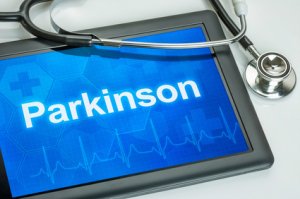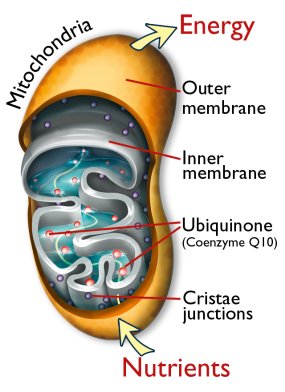Q10 may help people with Parkinson’s disease
 According to a Japanese study, some people with Parkinson’s disease may find that coenzyme Q10 helps to relieve their symptoms. Q10 occurs in two forms, both of which have vital functions, but the scientists observed that only the one form had a positive effect on Parkinson’s disease. Nonetheless, when supplementing with Q10, both forms are equally good. What matters is that the active compound can be absorbed. Once it has been absorbed, the body can shift from one form to the other, a process that also requires selenium.
According to a Japanese study, some people with Parkinson’s disease may find that coenzyme Q10 helps to relieve their symptoms. Q10 occurs in two forms, both of which have vital functions, but the scientists observed that only the one form had a positive effect on Parkinson’s disease. Nonetheless, when supplementing with Q10, both forms are equally good. What matters is that the active compound can be absorbed. Once it has been absorbed, the body can shift from one form to the other, a process that also requires selenium.
Q10 is a remarkable molecule in that it contributes to cellular energy turnover while at the same time protecting cells against harmful free radicals. All cells in the body, brain cells included, are constantly bombarded by free radicals. The free radical load increases in connection with stress, ageing processes, poisoning, smoking, and radiation. It is vital to protect the brain with powerful antioxidants like Q10 through every stage of life. The human body is more or less self-sufficient when it comes to Q10, but as we grow older our endogenous production decreases. Disease, lack of selenium, and the use of cholesterol-lowering medicine may also inhibit our ability to produce Q10 and convert the compound from one form to the other.
Q10’s different forms
Q10 is found in two primary forms, one called ubiquinone that is needed for cellular energy turnover, and another called ubiquinol, which is a powerful antioxidant. Another name for ubiquinol is “active Q10”, but this term is actually misguiding, as both forms are active each in their own way.
Ubiquinone is the oxidized form of Q10 and is particularly important for the energy turnover that takes place inside the cellular ”powerhouses” (mitochondria). Ubiquinone is yellowish.
Ubiquinol is the non-oxidized (reduced) form that has two extra hydrogen molecules. Ubiquinol’s primarily functions as an antioxidant and has a milky white color.
The fascinating interchange requires selenium
Helped by selenium-dependent enzyme processes, ubiquinone and ubiquinol constantly change from one from to the other, depending on the body’s needs. It therefore makes no difference what form of Q10 we take as a supplement. The important thing is to choose a high-quality Q10 preparation that the body is able to absorb and convert. A problem is that the selenium intake has gone down because of factors such as our nutrient-depleted soil and a tendency to consume less fish and organ meat, which are otherwise excellent selenium sources.
This is why the scientists who conducted the Swedish KiSel-10 study gave supplements of both Q10 and selenium to a group of healthy older people. They included selenium to enhance the effect of Q10. The researchers specifically selected a type of selenium yeast that contains over 30 different organic selenium species.
Mitochondrial defects in Parkinson’s disease
Signs of defect brain cell mitochondria have been detected in Parkinson’s disease. This insidious disease typically starts at the age of 50-70 years and is caused by damaged nerve cells and lack of dopamine, a neurotransmitter. There are different stages of the disease, and the symptoms are typically uncontrolled tremor, muscle stiffness, slow movements, poor balance, lacking ability to control facial expressions, fatigue, impaired memory, and cognitive impairment.
Because the brain normally has a large energy turnover, it is vital that the nerve cell mitochondria function properly. The mitochondria even have other functions in the cells that are crucial for the cells’ ability to carry out their different tasks. It is therefore vital to support the mitochondria as a way of preventing and treating the disease.
The mitochondria help control the following:
|
Parkinson’s patients (different disease stages) received 300 mg of Q10
The Japanese scientists from Juntendo University demonstrated that ubiquinol can significantly reduce Parkinson’s symptoms. Their study lasted nearly two years and tested 58 patients in a randomized, double-blind placebo-controlled setting.
The first group consisted of 28 patients that had Parkinson’s disease at a stage where the effect of their medicine (levodopa) tapers off, which is rather common after a few years. All 28 patients in the first group continued taking their prescription medicine. Half of the patients (14 in total) got 300 mg of Q10 together with their medicine, while the remaining 14 patients got matching placebo with their medicine.
The other group of patients was in an earlier phase of Parkinson’s disease and had not yet begun taking levodopa. In a similar fashion, they were split into two groups – one group that got 300 mg of Q10 daily and one placebo group.
Before and after the study, all patients were assessed using a Parkinson’s rating scale called UPDRS (Unified Parkinson’s Disease Rating Scale), which is used to evaluate and measure the symptoms and their severity within categories like motor skills, cognitive functions, energy levels, and mood.
Q10 has a significant effect
When looking at the first group of patients (who took levodopa), the researchers found that those who took Q10 with their medicine had significantly higher UPDRS scale ratings than the patients who took placebo (their ratings went down).
In the other group with patients who did not take medicine, the researchers also found that those who took Q10 had significantly higher UPDRS ratings than the placebo group. It is important to note, however, that a deterioration was observed in both groups with the early stages of Parkinson’s disease. Still, the disease progression was slower among those who took Q10.
Q10’s unique absorption and conversion
Q10 in food and in supplements occurs as either ubiquinone or ubiquinol. Once it has been absorbed in the bloodstream, most ubiquinone is converted to ubiquinol, the form of the substance that is a powerful antioxidant. Ubiquinol protects cholesterol and prevents atherosclerotic plaque from forming in the blood vessel walls.
Once ubiquinol enters the cells in the body, it is converted into ubiquinone that helps the mitochondria produce ATP (adenosine triphosphate), which is energy stored chemically in molecular form.
|
Mitochondria are the cellular powerhouses where Q10 helps convert micronutrients into ATP, which is the most important energy source of all cells |
Supplements, quality, and effect
Q10 is a comparatively large, lipid-soluble molecule that the body is able to produce in a free form. In Q10 raw materials used to make supplements, the Q10 molecules tend to aggregate in crystals. These crystals are unable to pass through the intestinal membrane, unless the Q10 raw material has undergone a special treatment involving different oils and heat. Many people take supplements that have not been exposed to this treatment, which is why they do not feel the full effect of the Q10.
The quality of a Q10 preparation is therefore vital for the uptake and effect of the active ingredient. This is why scientists often choose high-quality Q10 supplements for their scientific studies.
Ubiquinol is very delicateQ10 supplements that contain ubiquinol are very delicate, as ubiquinol oxidizes whenever it is exposed to oxygen. The reaction with oxygen transforms ubiquinol back into ubiquinone. |
Q10 combined with creatine
Chinese scientists carried out a study of 75 patients with an early stage of Parkinson’s disease. The participants either got 300 mg of Q10 and 10 grams of creatine monohydrate, or matching placebo. Creatine is mainly found inside muscle tissue where it serves as a rapid energy provider. This is the reason why creatine supplements are popular among athletes who engage in “explosive” sports disciplines. Creatine, however, is also important for the energy turnover in brain and nerve cells, so it is always a good idea to combine Q10 with creatine.
The Chinese scientists found that the patients who got Q10 combined with creatine fared better than those in the placebo group after 12 and 18 months. The two supplements seemed to delay the deterioration of cognitive functions. The researchers also observed a lower degree of lipid peroxidation, which is one of the most dangerous effects of free radicals. Q10, thanks to its role as a powerful antioxidant, counteracts this process.
Consider supplementing with vitamin B3 (niacin)
We need vitamin B3 in order to synthesize NAD (nicotinamide adenine dinucleotide), which is a compound that is important for cellular energy metabolism and repair of damaged nerve cell DNA. Unbalanced diets, overconsumption of alcohol, and the use of antacids and diuretics (which many older people use) may cause vitamin B3 deficiencies or poor utilization of the nutrient.
References:
Yoritaka A et al. Randomized, double-blind, placebo-controlled pilot trial of reduces coenzyme Q10 for Parkinson´s disease. PubMed 2015
Li Z et al. The effect of creatine and coenzyme Q10 combination therapy on mild cognitive impairment in Parkinson´s disease. PubMed 2015
University of Leicester. People with forms of early-onset Parkinson´s disease may benefit from boosting niacin in diet, research suggest. ScienceDaily. 2017
Lehmann S. et al. Enhancing NAD salvage metabolism is neuroprotective in a PINK1 model of Parkinson´s disease. Biology Open 2016
https://www.sundhed.dk/borger/patienthaandbogen/hjerne-og-nerver/sygdomme/parkinson/parkinson-behandling/
Pernille Lund. Q10 - fra helsekost til epokegørende medicin. Ny videnskab 2014
Search for more information...
- Created on .









